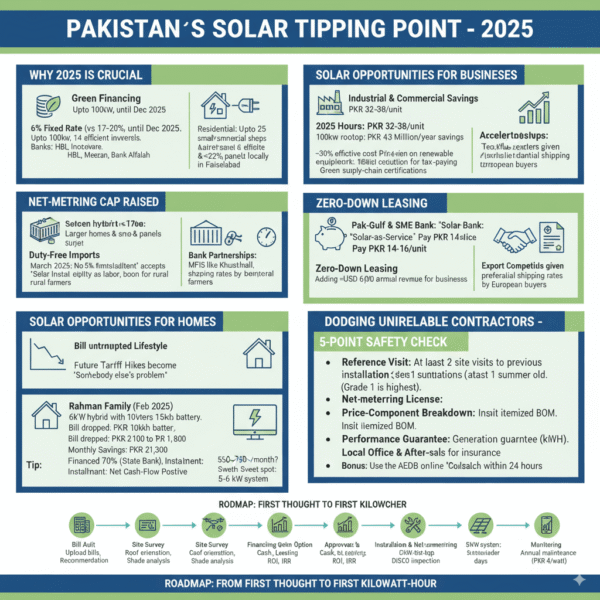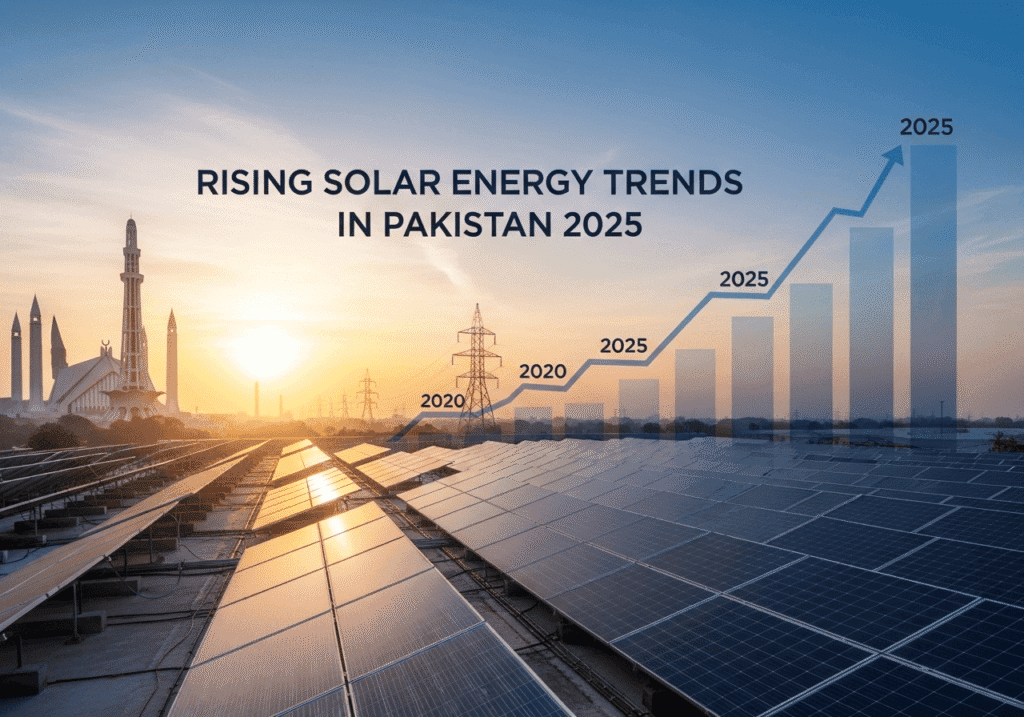Golden Opportunities for Homes & Businesses
“Last month my neighbour paid PKR 28 per unit, while I paid nothing—zero—because my rooftop was quietly doing the work.” In fact, if sleepless nights have been caused by inflated electricity bills, sudden load-shedding, or voltage fluctuations, you are being heard.
According to recent data, the State Bank of Pakistan shows that residential solar financing grew 64% year-on-year in the first quarter of 2025. Moreover, more than 72,000 net-metering licences have already been issued across the country, and ‘solar-ready homes’ are now advertised by every third housing scheme in Lahore, Islamabad, and Karachi.
Now imagine watching the electricity meter spin backwards while WAPDA struggles with yet another power breakdown. As a result, you can protect your family or your factory from tariff shocks for the next 25 years—because that is how long modern Tier-1 panels are warranted.
Therefore, before you spend another rupee on diesel gensets or UPS batteries, spend two minutes reading this guide. Finally, when you are ready, Paragon Green Energy offers a free consultation that can be booked at the click of a button.”
Electricity tariffs have shot up 44 % since 2022, and outages of 6–10 hours still hit small cities every week. It is frustrating, it is unpredictable, and it is not your fault.
In the next 1,500 words you will be shown the latest solar energy trends 2025 that are quietly cutting monthly bills by 50–90 %, plus the financing shortcuts that slash upfront costs.
The article is divided into six bite-sized sections:
- Why 2025 is a tipping point
- Opportunities for homes
- Opportunities for businesses
- How to dodge unreliable contractors
- Step-by-step roadmap to going solar
- FAQs and a personalised next step

1. Why 2025 Is the Tipping Point for Solar Energy in Pakistan
- State Bank’s Green Financing Scheme and Residential Solar Loans
A 6 % fixed financing rate (vs. the usual 17–20 %) has been extended to December 2025 for systems up to 100 kW. Processing time has also been reduced to 14 days through designated banks such as HBL, Meezan and Bank Alfalah. - Net-metering cap raised
The National Electric Power Regulatory Authority (NEPRA) has allowed households to install systems up to 25 kW instead of the previous 17 kW, making larger homes and small commercial shops eligible. - Government Policies, Duty-Free Imports, and AEDB Incentives
In March 2025, the federal cabinet waived the 5 % customs duty on inverters above 98 % efficiency and Tier-1 panels above 22 % efficiency. Prices have fallen 8–10 % in the last quarter alone. - Bank partnerships
Micro-finance institutions such as Khushhali Bank and NRSP have launched ‘solar instalment’ products, accepting 30% equity in the form of labour, a boon for rural farmers. - Technology upgrade
N-type TOPCon panels with 23 % efficiency are now assembled locally in Faisalabad, bringing high-spec hardware within reach of middle-income families.
2. Solar Opportunities for Homes
(Keep your electricity bill nearby; the numbers will start making sense immediately.)
2.1 Bill Slashing, Not Bill Shaving
A 5 kW system in Lahore produces roughly 635 kWh per month. At the current AEDB-notified rate of PKR 28.4 per unit, that is PKR 18,034 of electricity every month, or PKR 216,408 per year. The same 5 kW installation is currently quoted (May 2025) at PKR 850,000 after the duty waiver. Simple payback: 3.9 years; after that, free power for the remaining 21+ years of panel life.
2.2 Protection Against Tariff Escalation
WAPDA has sought an additional PKR 5.75 per unit surcharge for FY26. When you own the power plant on your roof, future hikes become somebody else’s headache.
2.3 Uninterrupted Lifestyle
Modern hybrid inverters switch to battery mode in 15 milliseconds—faster than a UPS—so your smart TV does not reboot and your CCTV stays on even during street outages.
2.4 Urban Home Case Study
The Rahman family in Karachi’s Gulistan-e-Jauhar installed a 6 kW hybrid system with a 10 kWh lithium battery in February 2025. Their bill dropped from PKR 23,100 to PKR 1,800 (minimum meter rent). Monthly savings: PKR 21,300. They financed 70 % through the State Bank scheme; instalment: PKR 17,900. Net cash-flow positive from day one.
Tip: If monthly consumption is 550–750 units, the sweet-spot size is 5–6 kW. Oversizing invites higher upfront cost; under-sizing leaves money on the table.
3. Solar Opportunities for Businesses
3.1 Industrial & Commercial Tariffs
Pakistan’s industry pays PKR 32–38 per unit during peak hours. A 100 kW rooftop system generates around 130,000 kWh annually, translating to savings of PKR 4.3 million per year.
3.2 Accelerated Depreciation
The 2025 Finance Act allows 90 % first-year depreciation on renewable-energy equipment, cutting the effective system cost by almost 30 % for tax-paying companies.
3.3 Zero-Down Leasing
Solar-as-a-Service’ is now being offered by leasing companies such as Pak-Gulf and SME Bank, where only PKR 14–16 per unit is paid by the business, while ownership is transferred after year 7.
3.4 Export Sector Competitiveness
Textile exporters in Faisalabad report that solar-powered mills are being given preferential shipping rates by European buyers who require green supply-chain certification.
3.5 Business Case Study
A plastic-moulding unit in Sialkot installed a 250 kW on-grid system in January 2025. Annual production: 325 MWh. Upfront cost after duty waiver: PKR 13.8 million. First-year depreciation tax shield: PKR 4.1 million. Net payback: 2.3 years. Carbon credits are now being registered, adding another USD 6,000 of annual revenue.
4. Dodging Unreliable Contractors – A 5-Point Safety Check
- Reference Visit
Demand at least two site visits to previous installations that are at least one summer old. - Net-Metering Expansion and Licensing in Pakistan 2025
Only AEDB-graded vendors can submit net-metering applications. Ask for the Grade letter (Grade 1 is highest). - Price-Component Breakdown
A low quote often hides cheap mounting rails and DC breakers. Insist on itemised BOM (bill of materials). - Performance Guarantee
Reputable firms provide a generation guarantee (kWh) backed by insurance. - Local Office & After-sales
It should be checked if a local technician—not a call centre—can be dispatched within 24 hours.
Bonus: Use the AEDB online “Solar Vendor Blacklist” before signing any contract.
5. Roadmap: From First Thought to First Kilowatt-Hour
Step 1 – Bill Audit
Upload your last electricity bills to Net Metering Calculator; receive a size recommendation in 24 hours.
Step 2 – Site Survey
A technical team measures roof orientation, tilt, and structural integrity. Shade analysis is done through drones.
Step 3 – Financing Option Comparison
A side-by-side comparison of cash, bank financing, and leasing is prepared. ROI and IRR are calculated for each.
Step 4 – Approvals & Net-metering Application
The vendor submits the application to the relevant DISCO (LESCO, IESCO, KE, etc.). An acknowledgement copy is given to you.
Step 5 – Installation & Commissioning
The installation of a 5 kW system is normally completed in 3 working days; another day is required for DISCO inspection and meter change.
Step 6 – Monitoring & Maintenance
A mobile app displays real-time generation. Annual maintenance contracts start at PKR 4 per watt and include module washing, inverter firmware updates, and connector health checks.
6. Frequently Asked Questions
Q1: What is the cost of solar installation in Pakistan 2025?
On average, turnkey prices are:
- Off-grid: PKR 210,000 per kW
- Hybrid: PKR 170,000 per kW
- Off-grid: PKR 210,000 per kW
A drop of 5–7% in prices is expected in the next quarter due to increased local manufacturing.
Q2: How long does it take to recover solar investment?
The payback period varies by system size and location:
- 3 kW on-grid in Peshawar: 3.5 years
- 10 kW hybrid in Islamabad: 4.8 years
- 50 kW on-grid in Karachi: 3.2 years
After payback, the system generates free power for 20+ years.
Q3: Does solar work during load-shedding?
Yes, hybrid systems with a battery backup work during load-shedding. On-grid systems are designed to shut down during outages for safety reasons.
Q4: How to find a reliable solar contractor in Pakistan?
Use the 5-point safety check mentioned in Section 4. Always cross-check with AEDB’s vendor ratings and customer reviews on Google.
Q5: What are the main benefits of solar energy in Pakistan in 2025?
n 2025, solar energy in Pakistan offers major benefits such as reduced electricity bills, energy independence, eco-friendly power generation, and government-backed financing options through banks and SBP schemes.
Q6: How does net-metering work for residential solar systems?
Net-metering allows homeowners to connect their solar panels to the national grid. Extra electricity generated is sold back to the grid, and the credits are adjusted against monthly bills, making solar energy more affordable and profitable.
Q7: What is the future outlook for solar-ready homes in Pakistan?
With increasing demand, every third housing scheme in major cities like Lahore, Islamabad, and Karachi is now advertising solar-ready homes. This trend shows that solar energy will become a standard feature of sustainable housing in Pakistan.
Future Outlook: Solar-Ready Homes & Pakistan’s Green Energy Growth
As Pakistan moves beyond 2025, solar energy is set to evolve from being an optional investment into a mainstream housing feature. Cities like Lahore, Karachi, and Islamabad are already showcasing “solar-ready homes,” where rooftops are designed for panel installation, and smart net-metering systems are integrated from the start. This reflects a nationwide shift towards sustainable urban living, reducing dependency on an unstable power grid.
For homeowners exploring solar research, it’s also helpful to use our solar quotation tool to estimate installation costs and learn more about other renewable energy solutions.
The momentum is being driven by supportive policies and financing. With the State Bank of Pakistan’s Green Financing Scheme, homeowners and businesses can access affordable loans for renewable projects. NEPRA’s expansion of net-metering licences and the government’s duty-free imports for solar equipment are further making adoption easier. Together, these measures are laying the foundation for entire communities powered by clean, renewable energy.
Looking ahead, solar-ready homes will play a central role in achieving Pakistan’s green energy goals, reducing fossil fuel reliance, and ensuring long-term energy independence. For investors, developers, and homeowners, the opportunity is clear: the future of Pakistan’s housing and energy sector is solar-powered.
Your Next Step
If you are ready to take control of your energy future, book a free consultation with Paragon Green Energy by clicking the button below. Our experts will guide you through the process, answer your questions, and help you unlock the full potential of solar energy.
Share Your Story
We would love to hear from you! Share your experiences, questions, or concerns in the comments section below. Your input helps us create content that truly addresses the needs of Pakistani homeowners and business owners.
Stay tuned for more insights and updates on solar energy in Pakistan. Together, let’s make the most of this renewable revolution.
Paragon Green Energy – Your Partner in Sustainable Energy Solutions
Contact us today and take the first step towards a brighter, more sustainable future.

